Water Conservation at Home and on the Farm
Dr Abe V Rotor
Part 1 - Automatic Rainwater Collection and Storage
Brisbane, Australia
Part 1 - Automatic Rainwater Collection and Storage in Brisbane, Australia
Part 2 - Water Conservation: Harvesting Rainwater in Metro Manila
Part 3 - "Palay-isdaan" (Rice-Fish Culture) - An Agro-Ecology Model
- Integrated with housing program
- Built-in system, pre-fabricated design
- Practical, easy to operate system
- Support from government and organizations
- Economical and environment-friendly
Water impounding on the countryside, Norvic Star cottage.
Part 2 - Water Conservation
Harvesting Rainwater in Metro Manila
A bountiful harvest of rainwater cuts down water bill; it is environment-friendly and
a source of enjoyment. At home, Lagro QC.
- Join downspouts together to maximize harvest of rainwater in one place.
- Keep roof, gutter and downspout regularly cleaned and declogged of any debris.
- Avoid using red lead paint, use epoxy paint instead, to avoid lead contaminant.
- Filter rainwater with fine screen or cloth before transferring to container.
- Plastic containers are convenient but they serve only as temporary storage.
- Wide mouth containers may cause accident. They are not designed as bath tubs.
- Use water within five days, otherwise it breeds mosquitoes and other vermin.
- Clean and expose containers under the sun for an hour or two to disinfect.
- Invert and be ready for the next rain to come. Store only clean rainwater.
- Final storage is ideally a garden pond. It is multipurpose: fish culture, water for cleaning, watering and for use in case of fire.

A garden pond adds aesthetic beauty to the place, adds coolness and tranquility, cum a gentle sound of a fountain and running stream. Garden Pond at home in Lagro, QC. Take Nature Home mural painting by the author.
Catfish and pako fish raised in a garden pond at author's residence.
Part 3
"Palay-isdaan" (Rice-Fish Culture)
An Agro-Ecology Model
Dr Abe V Rotor
Living with Nature Center Garden Pond
San Vicente, Ilocos Sur
Palay-isdaan is a revival of a virtually lost art and indigenous farming system and industry. Since the late fifties, the introduction of pesticides and chemical fertilizers and their rampant use decimated wildlife in ricefields. As a rule therefore, the ricefields must be free of these poisons, for palay-isdaan to succeed.




Top, clockwise: lowland ricefield during monsoon season; harvesting fish ahead of rice harvest as monsoon ends; close-up of Azolla, aquatic fern as natural source of fertilizer, fish food, and mulch in controlling weeds in the ricefield; duck raising may be integrated with rice-fish culture.
 Many wildlife species are found in ricefields as their natural habitat. These are commonly freshwater fish like hito, dalag, gurami, martiniko, and lately, since the fifties, tilapia. Then we have ulang PHOTO (freshwater lobsters), shrimps, kuhol, PHOTO suso’, and tulya.
Many wildlife species are found in ricefields as their natural habitat. These are commonly freshwater fish like hito, dalag, gurami, martiniko, and lately, since the fifties, tilapia. Then we have ulang PHOTO (freshwater lobsters), shrimps, kuhol, PHOTO suso’, and tulya. 
Strong rains release these organisms from their hibernation, usually in carabao wallows, ponds, and river basins – or in mud where they were ensconced during summer. The ricefields become one huge lake at the peak of the rainy season, and as the water subsides, these organisms are trapped in the paddies. Farmers pick them up for food, which is indeed a good source of protein for his family. Many find it a sport hunting them, while others find ways of protecting them until they reach maturity. The latter is the basis of palay-isdaan technology, which has these features.
2. Another model is to build a wide trench, 3 to 4 meters wide and one-half meter deep, running through the center of the rice paddy. This is usually done in low-lying areas where the water stays much longer. The trench serves as a natural trap for the fish as the surrounding water subsides.
3. A third model is recommended for irrigated areas where the rice field is managed like a fishpond. Here the farmer selects the fish he wants to grow, provides them with supplemental feeds, and gives attention more than what the other two models require. A commercial model would mean converting 30 percent of the total area into trenches.
------------------------------------------------------------
Palay-isdaan is a revival of a virtually lost art and indigenous industry. Since the late fifties, the introduction of pesticides and chemical fertilizers and their rampant use decimated wildlife in ricefields. As a rule therefore, unless the ricefields are free of these poisons, palay-isdaan will never succeed.
-----------------------------------------------
4. Because it takes time for the fish to grow to maturity it is advisable to plant traditional varieties which mature in 110 to 130 days. But this is feasible only where the rainy season is long and water supply is readily available. Traditional varieties generally do not need chemical spraying and fertilization.
Well-managed rice-fish farms in Central Luzon and other parts of the country can yield as much as 200 kg of tilapia per hectare. At P100 per kilo, the gross value is P20,000. While this gives around15 percent additional income, the farmer should consider a reduction in rice yield by at least 5 percent. Still palay-isdaan gives more income than rice monoculture.
Irrigated areas can have two fish crops a year, but this is not advisable because of the high cost of irrigation. Besides, it is virtually impossible to grow palagad rice (summer crop) without heavy dependence on chemical pesticides and fertilizers.~
-----------------------
Palay-isdaan is a practical and cheap source of food and nutrition for the farming family. It provides a natural sport and recreation most especially to children. Palay-isdaan is among the attractions in agro-tourism.
--------------
Acknowledgement: Internet photos















No comments:
Post a Comment